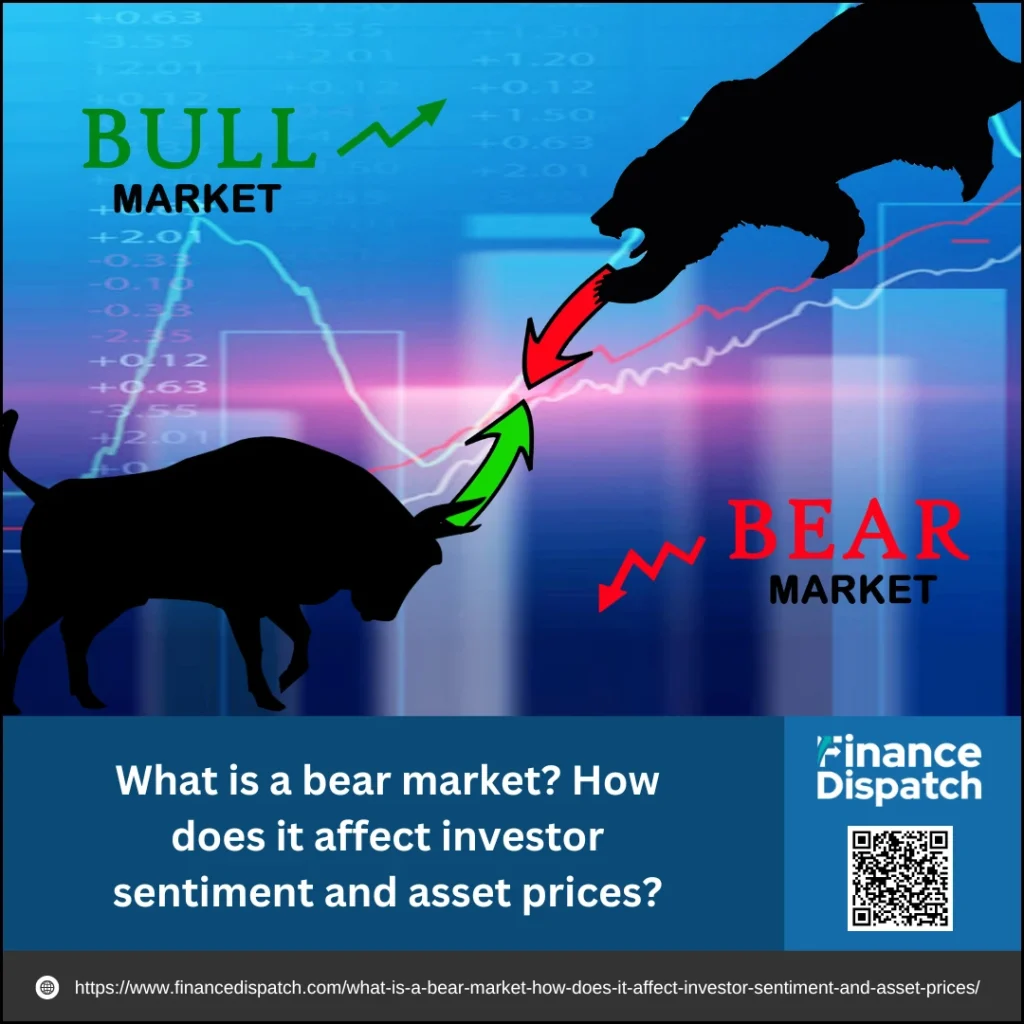A bear market is a period of prolonged price declines in financial markets, typically defined by a drop of 20% or more from recent highs. It is often accompanied by widespread investor pessimism, reduced trading activity, and increased market volatility. While bear markets can be challenging, they are a natural part of the economic cycle and can affect various asset classes, including stocks, bonds, and cryptocurrencies. Understanding what triggers a bear market, how it impacts investor sentiment, and its effect on asset prices is crucial for navigating periods of economic downturn. In this article, we will explore the characteristics of a bear market, its causes, psychological impact, and strategies investors can use to protect their portfolios and identify potential opportunities during market downturns.
What is a Bear Market?
A bear market is a financial market condition characterized by a prolonged decline in asset prices, typically defined as a drop of 20% or more from recent highs. This downward trend is often accompanied by negative investor sentiment, reduced trading activity, and economic uncertainty. Bear markets can occur in various asset classes, including stocks, bonds, real estate, and cryptocurrencies. Unlike short-term market corrections, which are brief and often followed by a rebound, bear markets can last for months or even years, leading to significant financial losses for investors. They are usually triggered by factors such as economic recessions, rising interest rates, geopolitical tensions, or shifts in market confidence. While bear markets can be challenging, they also present opportunities for disciplined investors to buy undervalued assets and position themselves for future growth when the market recovers.
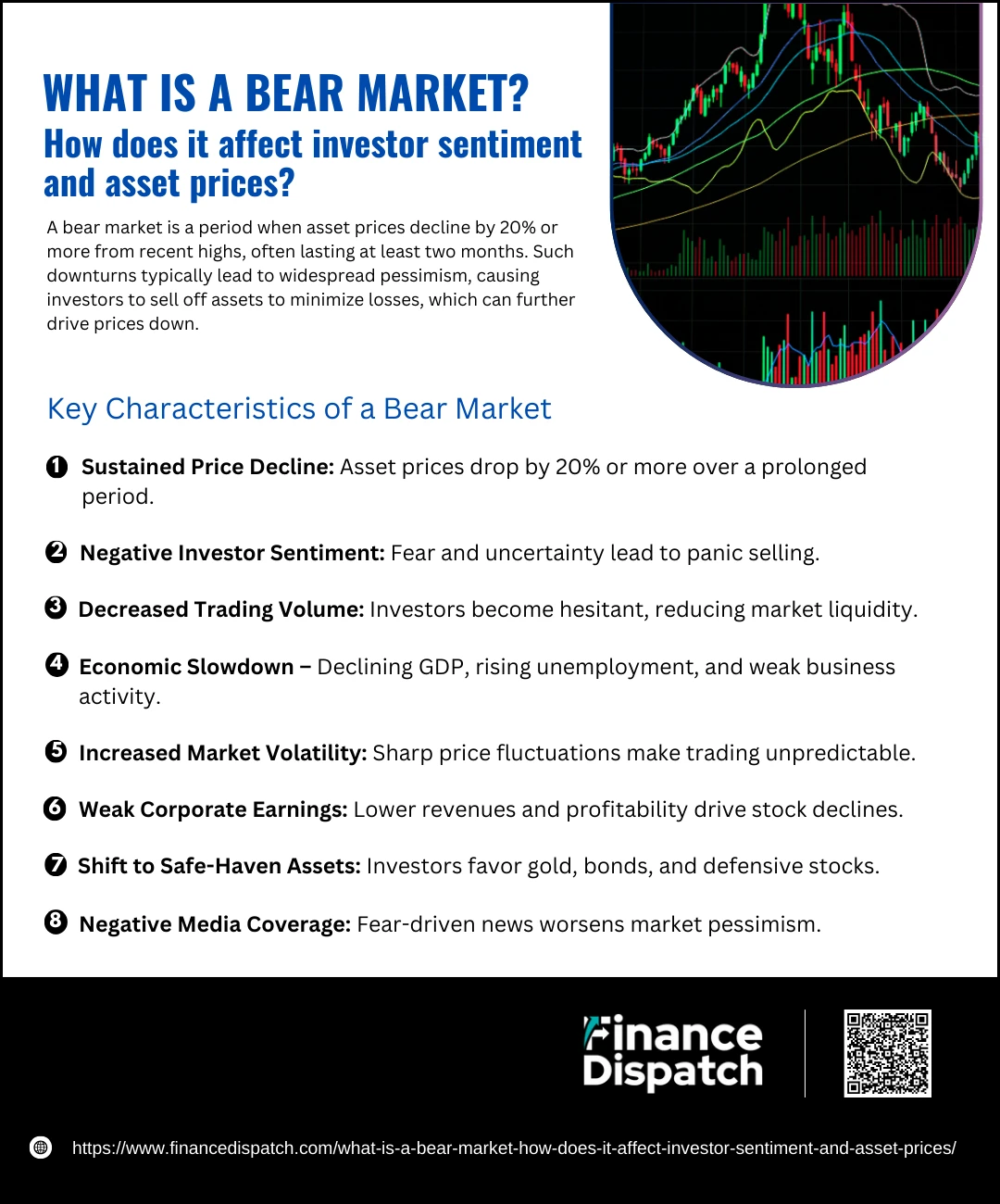 Key Characteristics of a Bear Market
Key Characteristics of a Bear Market
A bear market is a prolonged period of declining asset prices, typically marked by a drop of 20% or more from recent highs. This downturn is often driven by economic slowdowns, investor pessimism, and declining corporate earnings. Unlike short-term corrections, bear markets can last for months or even years, leading to a cycle of fear and reduced market participation. Investors become more risk-averse, preferring safer assets over volatile stocks. Understanding the key characteristics of a bear market helps investors recognize early warning signs and adjust their strategies to minimize losses and identify potential opportunities.
Key Characteristics of a Bear Market
1. Sustained Price Decline
A defining feature of a bear market is a prolonged drop in asset prices, with stock indices or individual assets declining by 20% or more from their recent highs. This decline can be gradual or sharp, depending on market conditions and external economic factors.
2. Negative Investor Sentiment
Fear and uncertainty dominate the market as investors lose confidence in future gains. This often leads to panic selling, where investors rush to offload their holdings to avoid further losses, creating a self-reinforcing downward spiral.
3. Decreased Trading Volume
As investors become hesitant to take risks, trading activity slows down. Many investors prefer to hold cash or move funds into safer investments, leading to lower liquidity and further market declines.
4. Economic Slowdown
Bear markets are often accompanied by broader economic troubles, such as declining GDP growth, rising unemployment, lower consumer spending, and reduced business investments. These factors weaken corporate earnings and further reduce investor confidence.
5. Increased Market Volatility
During bear markets, price fluctuations become more extreme, with sharp rebounds followed by steep declines. This unpredictability makes it challenging for investors to time their entries and exits effectively.
6. Weak Corporate Earnings
As economic activity slows down, businesses experience lower revenue and profitability. Weak corporate earnings reports contribute to negative sentiment, leading to stock price declines and further discouraging investment.
7. Shift to Safe-Haven Assets
To minimize risk, investors often move funds into safer investments like gold, government bonds, and defensive stocks (such as utilities, healthcare, and consumer staples) that tend to perform better during economic downturns.
8. Negative Media Coverage
Bear markets are often accompanied by negative financial news, with media outlets emphasizing market losses, economic troubles, and predictions of further downturns. This creates additional fear and uncertainty among investors, further reinforcing the downward trend.
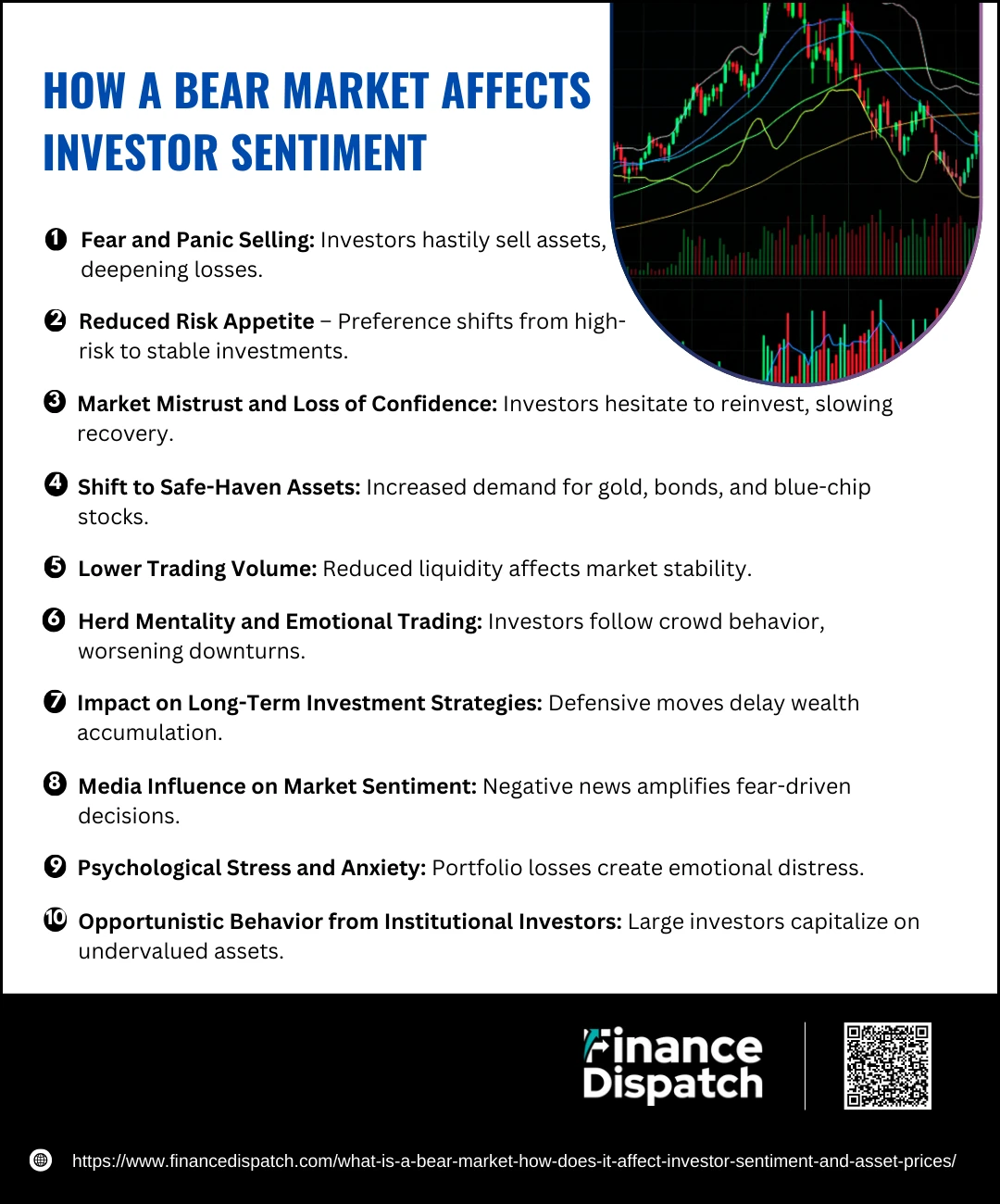 How a Bear Market Affects Investor Sentiment
How a Bear Market Affects Investor Sentiment
A bear market significantly impacts investor sentiment, often leading to fear, uncertainty, and risk-averse behavior. When asset prices decline by 20% or more, investors tend to lose confidence in the market, causing widespread pessimism and panic selling. The psychological effects of a bear market can influence investment decisions, leading to emotional trading, reduced participation, and a shift towards safer assets. Understanding how bear markets shape investor sentiment can help investors make informed decisions and avoid impulsive reactions that could harm their portfolios.
Effects of a Bear Market on Investor Sentiment
1. Fear and Panic Selling
As prices decline, fear takes over, prompting many investors to sell their assets hastily in an attempt to minimize losses. This panic selling often exacerbates the downturn, pushing prices even lower.
2. Reduced Risk Appetite
Investors become more cautious and shift their focus from high-growth investments to more stable and defensive assets, such as bonds, gold, and dividend-paying stocks. This leads to reduced participation in riskier markets like equities and cryptocurrencies.
3. Market Mistrust and Loss of Confidence
Repeated downturns can erode investor trust in the market’s ability to recover. Many investors may hesitate to reinvest, fearing further losses, which slows down market recovery.
4. Shift to Safe-Haven Assets
Investors tend to move funds into safer investments such as government bonds, gold, and blue-chip stocks, which are perceived as more resilient during economic downturns.
5. Lower Trading Volume
As confidence declines, investors trade less frequently, leading to reduced liquidity in the market. This drop in trading volume can create challenges in price discovery and further destabilize market conditions.
6. Herd Mentality and Emotional Trading
Investors often follow the crowd, leading to exaggerated market movements. When widespread fear dominates, people sell based on emotions rather than fundamentals, worsening the downturn.
7. Impact on Long-Term Investment Strategies
Investors may shift from long-term growth strategies to short-term defensive moves, altering their investment approach and delaying wealth accumulation. Some may even abandon the market entirely, missing out on potential recovery gains.
8. Media Influence on Market Sentiment
Negative news coverage amplifies fear, reinforcing the perception that markets will continue to decline. Media-driven pessimism often leads investors to make irrational decisions based on headlines rather than financial fundamentals.
9. Psychological Stress and Anxiety
Watching portfolio values decline can lead to stress and anxiety among investors, affecting their decision-making ability. Many struggle to stay rational, leading to decisions based on emotions rather than strategy.
10. Opportunistic Behavior from Institutional Investors
While retail investors panic, institutional investors often see bear markets as opportunities to buy undervalued assets. This divergence in sentiment between retail and institutional investors plays a significant role in market dynamics.
How Bear Markets Impact Asset Prices
Bear markets lead to significant declines in asset prices across various financial markets, often creating uncertainty and volatility. As investor sentiment turns negative, demand for riskier assets falls, leading to widespread price drops in stocks, bonds, real estate, and cryptocurrencies. The impact on asset prices varies depending on market conditions, economic factors, and investor behavior. While some assets decline sharply, others may hold their value or even increase as investors seek safer alternatives. Understanding how bear markets affect different asset classes can help investors make informed decisions during downturns.
Effects of Bear Markets on Asset Prices
- Stock Market Decline – Equities experience significant drops as investor confidence wanes, often leading to a prolonged downturn in stock indices like the S&P 500 and Dow Jones.
- Increased Volatility – Asset prices fluctuate unpredictably, making it difficult for investors to determine market trends and future movements.
- Declining Corporate Valuations – Lower investor confidence and weaker earnings reports lead to a reduction in stock prices, making many companies appear undervalued.
- Bond Market Fluctuations – Government bonds may rise in value as investors seek safety, while corporate bonds may decline due to concerns over default risks.
- Cryptocurrency Sell-offs – Digital assets like Bitcoin and Ethereum often face steep declines as risk-averse investors pull funds from highly volatile markets.
- Real Estate Market Slowdown – Property values may drop due to reduced demand and higher borrowing costs, making it harder for homeowners and investors to sell at favorable prices.
- Commodities and Safe-Haven Assets Gain Strength – Gold, silver, and other safe-haven assets often rise in value as investors seek stability during market downturns.
- Decreased Liquidity – Lower trading activity leads to reduced liquidity in financial markets, making it harder for investors to buy or sell assets without significant price changes.
- Dividend Cuts and Reduced Share Buybacks – Companies struggling with lower revenues may cut dividends or halt stock repurchase programs, further depressing share prices.
- Long-Term Investment Opportunities – While asset prices decline, long-term investors may find valuable opportunities to acquire quality assets at discounted prices.
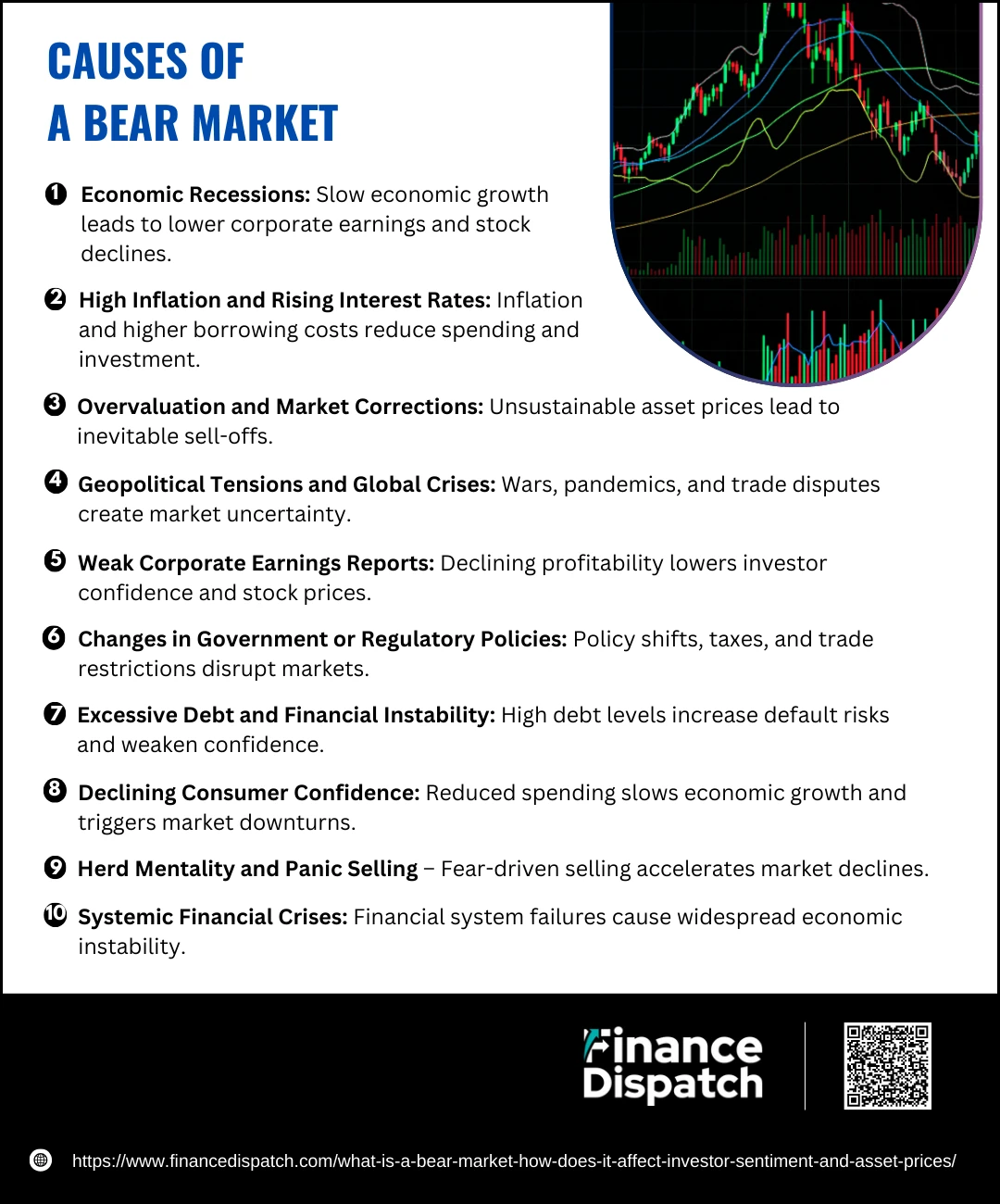 Causes of a Bear Market
Causes of a Bear Market
A bear market occurs when asset prices decline by 20% or more from their recent highs, often triggered by various economic, financial, and geopolitical factors. These downturns can be driven by investor fear, policy changes, or structural weaknesses in the market. Understanding the causes of a bear market can help investors anticipate market shifts and make informed decisions to protect their portfolios. While no single factor causes a bear market, a combination of key triggers often contributes to prolonged market declines.
Main Causes of a Bear Market
1. Economic Recessions
When economic growth slows or contracts, businesses generate lower revenues, leading to declining corporate earnings and weaker stock performance. High unemployment, lower consumer spending, and declining GDP are indicators of a looming bear market.
2. High Inflation and Rising Interest Rates
Inflation erodes purchasing power, reducing consumer and business spending. To combat inflation, central banks often raise interest rates, increasing borrowing costs and discouraging investment, which can trigger a bear market.
3. Overvaluation and Market Corrections
When asset prices become overinflated due to excessive speculation, a market correction is inevitable. When investors realize that valuations are unsustainable, they start selling off assets, leading to a broader market decline.
4. Geopolitical Tensions and Global Crises
Wars, trade disputes, and other geopolitical events create uncertainty, leading investors to pull money out of risky assets. Events such as the COVID-19 pandemic or financial crises can rapidly accelerate a market downturn.
5. Weak Corporate Earnings Reports
A decline in corporate earnings signals lower business performance and profitability. If a significant number of companies report weak earnings, investor confidence drops, leading to lower stock prices and potential bear market conditions.
6. Changes in Government or Regulatory Policies
Policy decisions, such as increased taxes, trade restrictions, or tighter financial regulations, can disrupt markets and limit economic growth. Uncertainty about government actions can reduce investor confidence and lead to market declines.
7. Excessive Debt and Financial Instability
High levels of corporate, government, or consumer debt can trigger financial instability. If businesses or consumers struggle to repay loans, defaults increase, reducing overall market confidence and leading to a downturn.
8. Declining Consumer Confidence
When consumers feel uncertain about the economy, they reduce spending and investment. Since consumer spending drives a significant portion of economic growth, reduced confidence can contribute to a bear market.
9. Herd Mentality and Panic Selling
Investor psychology plays a major role in market declines. When fear spreads, investors sell off assets to minimize losses, which can create a self-fulfilling cycle of further price drops and prolonged market downturns.
10. Systemic Financial Crises
Structural weaknesses in the financial system, such as the 2008 mortgage crisis, can cause widespread market collapses. When banks, financial institutions, or entire industries fail, the resulting instability can lead to prolonged bear markets.
The Psychological Impact of a Bear Market
A bear market not only affects asset prices but also has a profound impact on investor psychology. The sharp decline in market value, heightened volatility, and widespread uncertainty create fear, anxiety, and stress among investors. Many individuals react emotionally to these downturns, leading to impulsive decisions such as panic selling or abandoning long-term investment strategies. Understanding the psychological effects of a bear market can help investors maintain discipline, make rational choices, and navigate market downturns more effectively.
Psychological Effects of a Bear Market
- Fear and Anxiety – Watching portfolio values decline triggers emotional distress, leading many investors to make irrational decisions based on fear rather than logic.
- Panic Selling – Fear of further losses causes investors to sell assets prematurely, often locking in losses instead of waiting for market recovery.
- Loss of Confidence in the Market – Prolonged downturns lead to uncertainty, causing investors to question their strategies and hesitate to reinvest.
- Herd Mentality – Investors tend to follow the crowd, leading to mass sell-offs and further accelerating market declines.
- Short-Term Focus Over Long-Term Goals – Instead of sticking to a long-term investment plan, investors may shift their focus to immediate survival, abandoning sound financial strategies.
- Emotional Fatigue and Decision Paralysis – Constant market volatility creates mental exhaustion, making it difficult for investors to think clearly and take action.
- Increased Risk Aversion – After experiencing losses, many investors become overly cautious, avoiding the market even when conditions improve.
- Media Influence and Negative News Reinforcement – Sensational headlines amplify fear, making investors believe the downturn will last indefinitely.
- Regret and Self-Doubt – Investors who make emotional decisions often experience regret, leading to further hesitation in future investment choices.
- Opportunity for Growth and Learning – While bear markets are emotionally challenging, they also provide valuable lessons in risk management, market cycles, and long-term financial discipline.
Bear Market vs. Bull Market
Financial markets move through cycles of growth and decline, commonly referred to as bull and bear markets. A bull market is characterized by rising asset prices, strong investor confidence, and economic expansion, encouraging higher investment activity. In contrast, a bear market signifies prolonged declines, typically marked by a 20% or more drop in asset prices, widespread pessimism, and economic slowdown. Understanding the differences between these two market conditions helps investors adjust their strategies and make informed decisions based on market trends.
Comparison of Bear Market and Bull Market
| Aspect | Bear Market | Bull Market |
| Definition | A period of prolonged price declines, typically 20% or more. | A period of rising asset prices and strong market growth. |
| Investor Sentiment | Pessimistic, fearful, and risk-averse. | Optimistic, confident, and risk-seeking. |
| Market Trend | Downward trend in asset prices. | Upward trend in asset prices. |
| Economic Conditions | Often associated with recessions, weak GDP growth, and high unemployment. | Linked to economic expansion, strong GDP growth, and low unemployment. |
| Trading Activity | Decreased trading volume due to investor caution. | Increased trading volume as more investors participate. |
| Volatility | High volatility, with unpredictable price swings. | Relatively stable, with steady growth in asset prices. |
| Corporate Profits | Declining profits and weak earnings reports. | Strong corporate earnings and profitability. |
| Investment Strategies | Defensive investing, portfolio diversification, and capital preservation. | Growth investing, buying high-risk assets, and maximizing returns. |
| Typical Duration | Can last months to years, depending on economic conditions. | Typically lasts longer than bear markets, often several years. |
| Examples | The 2008 Financial Crisis, COVID-19 market crash (2020). | The post-2009 bull market, dot-com boom (1990s). |
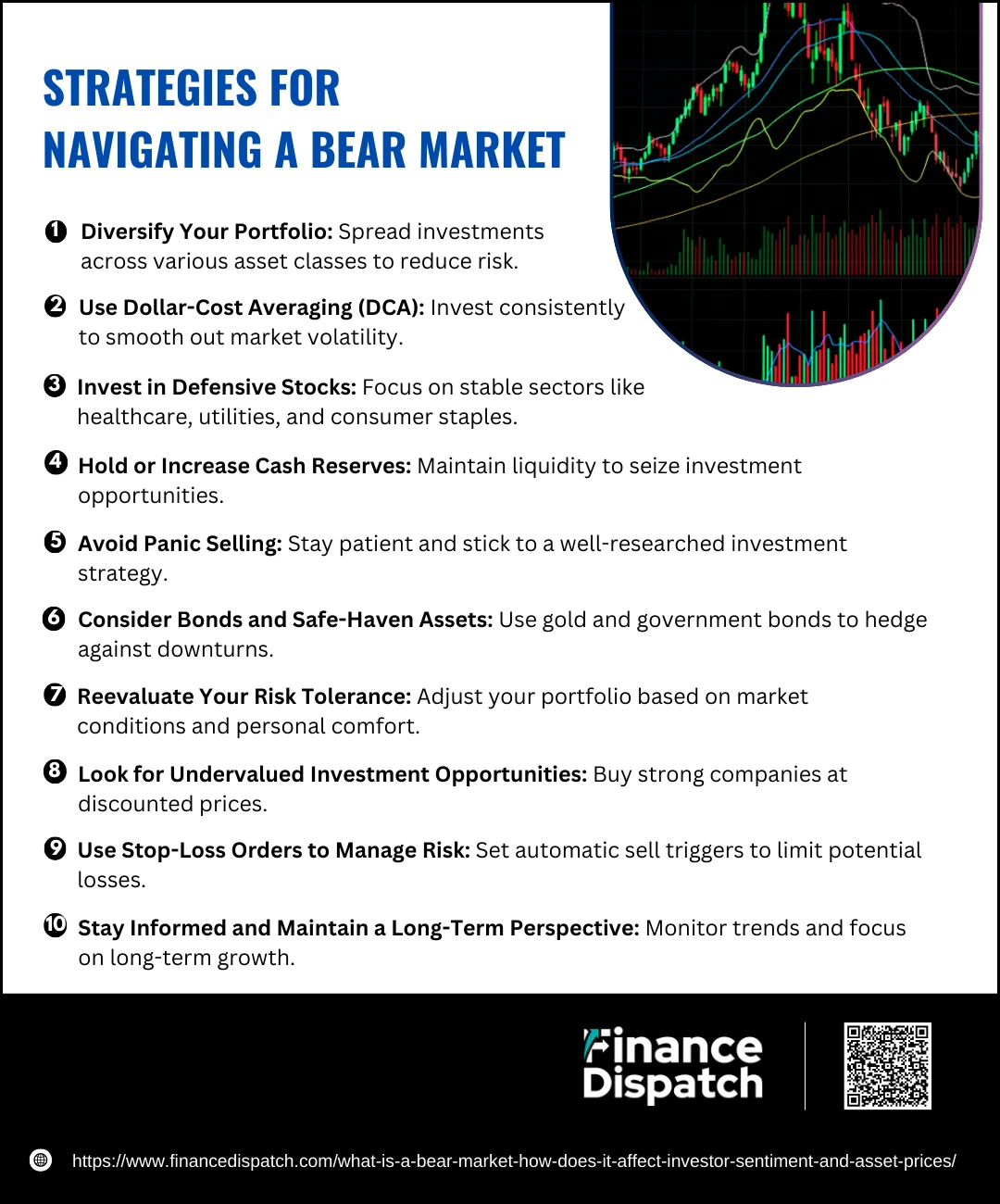 Strategies for Navigating a Bear Market
Strategies for Navigating a Bear Market
A bear market can be an unsettling time for investors, marked by declining asset prices, economic uncertainty, and increased volatility. Fear and panic selling often lead to further losses, making it crucial for investors to adopt disciplined strategies to protect their capital and position themselves for future growth. While bear markets can be challenging, they also provide opportunities to buy quality assets at discounted prices. The key to navigating a bear market successfully is staying informed, managing risks effectively, and maintaining a long-term perspective. Below are some proven strategies to help investors weather a bear market and make the most of market downturns.
Key Strategies for Navigating a Bear Market
1. Diversify Your Portfolio
Reducing risk by spreading investments across multiple asset classes can help cushion losses. A well-diversified portfolio includes a mix of stocks, bonds, commodities, real estate, and alternative assets. Diversification minimizes the impact of a decline in any single sector or asset class, ensuring stability during market downturns.
2. Use Dollar-Cost Averaging (DCA)
Rather than trying to time the market, investing a fixed amount at regular intervals (e.g., monthly or quarterly) helps smooth out market volatility. This strategy allows investors to buy more shares when prices are low and fewer shares when prices are high, reducing the average cost of investments over time.
3. Invest in Defensive Stocks
Sectors such as healthcare, utilities, and consumer staples tend to perform better during bear markets because they provide essential goods and services that people continue to use regardless of economic conditions. Investing in companies with strong balance sheets and steady cash flows can provide stability during turbulent times.
4. Hold or Increase Cash Reserves
Keeping cash on hand gives investors the flexibility to take advantage of buying opportunities when high-quality assets become undervalued. Cash also provides financial security, reducing the need to sell investments at a loss during market downturns.
5. Avoid Panic Selling
Emotional reactions to market declines often lead to poor decision-making. Selling investments in a panic locks in losses and prevents investors from benefiting when the market eventually recovers. Staying patient and sticking to a well-researched investment strategy is essential for long-term success.
6. Consider Bonds and Safe-Haven Assets
Government bonds, gold, and other low-risk assets tend to hold their value or even appreciate during bear markets. Allocating a portion of a portfolio to these assets can provide stability and act as a hedge against declining stock prices.
7. Reevaluate Your Risk Tolerance
Bear markets are a good time to reassess investment goals and risk tolerance. Investors who find themselves overly stressed by market downturns may need to adjust their asset allocation to a more conservative strategy with lower volatility.
8. Look for Undervalued Investment Opportunities
Many high-quality stocks become significantly undervalued during bear markets. Investors who can identify fundamentally strong companies with good long-term growth potential may find excellent buying opportunities at discounted prices.
9. Use Stop-Loss Orders to Manage Risk
Stop-loss orders automatically sell a security when its price falls to a predetermined level, helping investors limit potential losses. This strategy is particularly useful in volatile markets, as it prevents investments from declining too far before action is taken.
10. Stay Informed and Maintain a Long-Term Perspective
Market downturns are a natural part of economic cycles, and historically, markets have always recovered over time. Staying updated on market trends, economic indicators, and financial news helps investors make informed decisions. Maintaining a long-term mindset prevents unnecessary panic and ensures that investment decisions are based on fundamental analysis rather than short-term market fluctuations.
Real-World Examples of Bear Markets
Bear markets have occurred throughout history, often triggered by economic crises, geopolitical events, or speculative bubbles. These downturns lead to significant declines in asset prices, investor panic, and economic slowdowns. While bear markets can be challenging, they also offer valuable lessons on market resilience and recovery. Here are some notable examples:
Notable Bear Markets in History
- The Great Depression (1929–1932) – The worst bear market in history, with the Dow Jones falling nearly 90%, leading to a global economic collapse.
- Oil Crisis Bear Market (1973–1974) – A sharp stock market decline caused by an oil embargo, soaring inflation, and a deep recession.
- Black Monday Crash (1987) – A one-day stock market crash where the Dow Jones dropped 22.6%, mainly due to automated trading.
- Dot-Com Bubble Burst (2000–2002) – Overinflated tech stocks collapsed, wiping out billions in investor wealth and dropping the Nasdaq by nearly 78%.
- Global Financial Crisis (2007–2009) – A housing market collapse led to a financial meltdown, with the S&P 500 falling over 50%.
- COVID-19 Crash (2020) – Markets plunged over 30% in weeks due to pandemic-induced uncertainty, but rebounded quickly.
- 2022 Bear Market – Rising inflation, interest rate hikes, and global tensions led to significant stock market declines.
Conclusion
Bear markets are a natural part of financial cycles, often triggered by economic downturns, inflation, geopolitical events, or market corrections. While they can be challenging and emotionally taxing for investors, history has shown that markets eventually recover, leading to new periods of growth. Understanding the causes, characteristics, and psychological impact of bear markets helps investors make informed decisions, avoid panic-driven mistakes, and adopt strategies that protect their portfolios. By focusing on diversification, risk management, and long-term investment principles, investors can not only withstand market downturns but also capitalize on opportunities that arise during these periods. Patience, discipline, and a strategic approach are key to navigating bear markets successfully and emerging stronger when the market rebounds.



